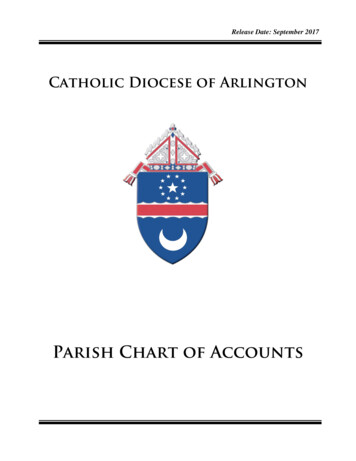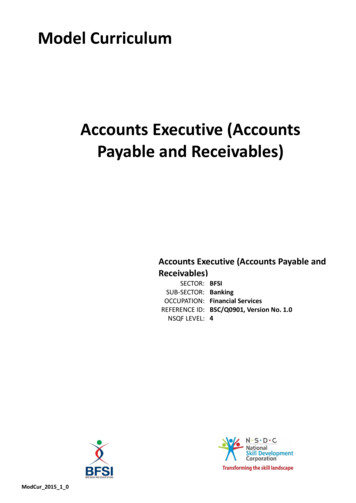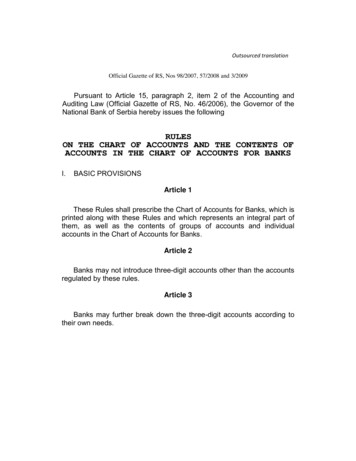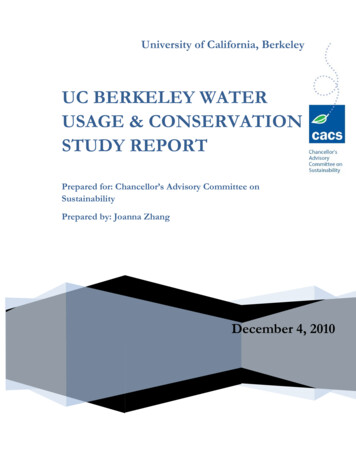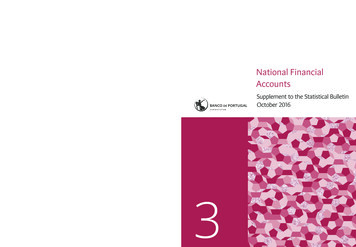
Transcription
National FinancialAccountsBANCO DE PORTUGALEUROSYSTEM3Supplement to the Statistical BulletinOctober 2016
3National Financial AccountsSupplement to the Statistical BulletinOctober 2016Lisbon, 2016 www.bportugal.pt
National Financial Accounts Supplement to the Statistical Bulletin 3 2016 Banco de Portugal Av. Almirante Reis, 71 1150-012 Lisboa www.bportugal.pt Editing Statistics Department Design and Printing Communication Directorate Image and Graphic Design Unit ISBN 978-989-678-542-0 (online) ISSN 2182-1747 (online) Legal deposit no. 135690/99
ContentsIntroduction 51. Methodological framework 91.1. General aspects 9Box 1 Cooperation with INE 101.2. Institutional sectors 101.3. Financial instruments 121.4. Types of information 131.5. Valuation criteria 151.6. Horizontal and vertical consistency 151.7. Whom-to-whom matrices and flow of funds 17Box 2 Information broken down by counterparty sector 181.8. Data sources 201.9. Dissemination 212. Presentation of main results 222.1. Twenty years of information on the national financial accounts 222.2. Financial assets and liabilities 2007-2015 232.3. Financial transactions 2007-2015 283. Relationships between institutional sectors 32Box 3 Flows of funds charts 32Acronyms and abbreviations 35References 36Supplements to the Statistical Bulletin 37
List of FiguresFigure 1 Relationship between types of information 14Figure 2 Horizontal consistency 16Figure 3 Vertical consistency 17List of ChartsChart 1 Net financial worth (1995-2015) 22Chart 2 Financial saving (1995-2015) 23Chart 3 Net financial worth Contribution of the various institutional sectors 24Chart 4 Assets and liabilities of non-financial corporations Composition by financial instrument 25Chart 5 Assets and liabilities of financial corporations Composition by financial instrument 26Chart 6 Assets and liabilities of the general government Composition by financial instrument 26Chart 7 Financial assets and liabilities of households NPISH Composition by financial instrument 27Chart 8 Financial saving Contribution of the different institutional sectors 28Chart 9 Non-financial corporations Net transactions 29Chart 10 Financial corporations Net transactions 30Chart 11 General government Net transactions 30Chart 12 Households NPISH Net transactions 31Chart 13 Flow of funds 33List of TablesTable 1 List of institutional sectors 11Table 2 Financial corporations and general government Institutional sub-sectors 12Table 3 Financial instruments Description 13Table 4 Valuation criteria Stocks 15Table 5 Example: vertical consistency – Households 17Table 6 Whom-to-whom matrix Example - Debt securities – transactions 19Table 7 External source Type of information 20
IntroductionThis supplement to the Statistical Bulletin aims to present the National Financial Accounts statistics produced by theStatistics Department of Banco de Portugal, explaining the respective concepts, methodologies, sources of informationand statistical results. This supplement to the Statistical Bulletin is an update to Supplements 3 2005 and 2 2005.The compilation of National Financial Accounts statistics by Banco de Portugal falls within the powers assigned to it by itsOrganic Law (Law No 5/98 of 31 January 1998 as amended) and by the law governing the National Statistical System (LawNo 22/2008 of 13 May 2008). The distribution of competences and the cooperation mechanisms for the preparation of thenational accounts are established in a protocol signed in 1998 between Banco de Portugal and Instituto Nacional deEstatística – INE (Portuguese National Statistical Institute), the latter being responsible for compiling the national nonfinancial accounts and Banco de Portugal taking on responsibility for the compilation of the national financial accounts. Inorder to ensure the consistency between financial accounts and non-financial accounts, the above-mentioned protocolprovides for the establishment of mechanisms of cooperation, mutual consultation and methodological discussion on thecompilation of national accounts, in particular as regards the harmonised implementation of the European System ofNational and Regional Accounts.Banco de Portugal discloses statistics on National Financial Accounts in Table A.6 and in Chapter F. of the Statistical Bulletinand in BPstat Statistics Online. In the beginning of 2016 the publication of this information started to be accompanied bya Press Release summarising the main results for the quarter under review.This Supplement is divided into three chapters. The first chapter presents the methodological framework of the NationalFinancial Accounts statistics and some aspects relating to the compilation and dissemination of the Portuguese financialaccounts. The second chapter presents the main results of the National Financial Accounts over the past 20 years, with aparticular focus on the most recent period, in particular between 2007 and 2015. Finally, the third chapter analyses therelationships between institutional sectors for a particular financial instrument (in this case financial saving) based on theso-called whom-to-whom matrices, i.e. based on a three-dimensional reading of the National Financial Accountsinformation, which in addition to the institutional sector and financial instrument also shows the counterparty dimension.
National FinancialAccounts1. Methodological framework2. Presentation of main results3. Relationships between institutional sectors
National Financial Accounts 20161. Methodological framework1.1. General aspectsThe National Financial Accounts (hereinafter ‘financial accounts’) are one of the components of thenational accounts and can be described as a structured and coherent set of statistical information,which records financial transactions – flows and stocks – between the various institutional sectorsof the economy and between these sectors and the rest of the world, disaggregated by the severaltypes of financial instruments.The financial accounts are considered derivative statistics as they are based on a vast array ofother statistics, including, for instance, balance of payments statistics and monetary and financialstatistics.Aggregating multiple sources of information, financial accounts are extremely important foreconomic analysis, as they make it possible to quantify the impact of financial decisions of a hostof economic agents (grouped into institutional sectors). This has become particularly relevant amidchanges in inter-sector relationships in the Portuguese economy, following the outbreak of theglobal financial crisis and subsequently the European sovereign debt crisis.In addition, taking into consideration that they provide quite a comprehensive picture about thetypes of investment made and financing instruments used by economic agents, financial accounts– while synthetic statistical representation of the economy’s financial structure – have a significantanalytical value from the point of view of monitoring financial stability, as they enable, inter alia, theanalysis of the degree of intermediation of the financial sector and of the structure of private sectorwealth.One of the main results of the financial accounts consists in the calculation of the financial savingin different institutional sectors of the economy, i.e. the difference between investment in financialassets in a given period and liabilities taken on in the same period. The acquisition of financialassets and the issuing of liabilities in any given sector are the counterpart to the lending capacityor borrowing requirement that stems from the economic activity in the same sector during thesame period. 1 As a result, apart from any statistical discrepancies, the balance of financial and nonfinancial accounts will tend to be equal.Responsibility for compiling the financial accounts lies with Banco de Portugal, following a protocolsigned with INE in 1998 (see Box 1). The reasoning is that Banco de Portugal already produces ona regular basis a cluster of statistics necessary for the preparation of financial accounts, accordingto the provisions laid down in its Organic Law. In turn, the European Central Bank is the entityresponsible for compiling the financial accounts in the Monetary Union, relying for this purposeon the collaboration of the national central banks.1In non-financial accounts, the lending capacity or the borrowing requirement is calculated for each institutional sector through the difference betweenresources (revenue) and employment (expenditure).9
10BANCO DE PORTUGAL Supplement to the Statistical Bulletin 3Box 1 Cooperation with INEBanco de Portugal took over responsibility for the compilation of the financial componentof the Portuguese National Accounts, following a protocol signed in 1998 with INE, the lattercontinuing to ensure the production of the non-financial component of the nationalaccounts.As mentioned above, taking on responsibility for the production of financial accounts wasrelated to the fact that Banco de Portugal already produced on a regular basis a cluster ofstatistics for the preparation of financial accounts. These include balance of paymentsstatistics and monetary and financial statistics.However, the need to ensure a high degree of consistency between the financial accountsand the non-financial accounts (vertical consistency) became evident. Therefore, throughsaid protocol, it was also agreed that the two institutions would set up mechanisms forcooperation and mutual consultation and methodological discussion on the compilation ofnational accounts. It should be noted that this need is quite common to the majority ofeuro area countries, to the extent that the responsibility for the compilation of financialaccounts is usually taken on by the central banks.The mutual consultation between Banco de Portugal and INE has led to better quality inthe two types of accounts, including through the reassessment of basic information andstatistical criteria (for example at the level of the treatment given to specific operations withrelevance in information), in order to minimise statistical discrepancies.With regard to the conceptual reference of financial accounts, these statistics are prepared inaccordance with the guidelines set out in the European System of National and Regional Accounts(ESA 2010) 2 – Regulation (EU) No 549/2013 of the European Parliament and of the Council of 21May 2013.As mentioned above, the financial accounts are a structured and coherent set of statisticalinformation based on a clear organisation of the various elements involved, in particular theinstitutional sectors, the financial instruments, the types of information and the valuation criteria,which are discussed below in this chapter.1.2. Institutional sectorsIn the preparation of financial accounts, economic agents are grouped into institutional sectorsaccording to the type of producer, function and main activity.According to the sectoral classification rules introduced by ESA 2010, the list used by the financialaccounts is presented in the table below (Table 1).2ESA 2010 is a harmonised benchmark on the methodology, compilation and timing for dissemination of National Accounts in the European Unioncountries, corresponding to the European version of the National System of Accounts 2008 (NSA 2008), compiled under the guidance of variousinternational organizations, namely the Eurostat, the International Monetary Fund, the Organization for Economic Cooperation and Development, theUnited Nations and the World Bank.
National Financial Accounts 2016Table 1 List of institutional sectorsInstitutional sectorDescriptionNon-financial corporationsInstitutional units which are independent legal entities and market producers,(S.11)and whose principal activity is the production of goods and non-financial services.Financial corporationsInstitutional units which are independent legal entities and market producers,(S.12)and whose principal activity is the production of financial services.General government (S.13)Public institutional units which are non-market producers whose output isintended for individual and collective consumption, and are financed bycompulsory payments made by units belonging to other sectors, and institutionalunits principally engaged in the redistribution of national income and wealth.Households NPISH (S.14Households (S.14) and Non-profit institutions serving households (S.15) S.15)Households (S.14)Individuals or groups of individuals, as consumers and as entrepreneursproducing market goods and non-financial and financial services (marketproducers), provided that the production of goods and services is not by separateentities treated as quasi-corporations. It also includes individuals or groups ofindividuals as producers of goods and non-financial services for exclusively ownfinal use.Non-profit institutionsPrivate institutional units which are separate legal entities, which serveserving householdshouseholds and which are non-market producers.(S.15)Rest of the world (S.2)Non-resident units in the economic territory of a country insofar as they areengaged in transactions with resident institutional units, or have other economiclinks with resident units.Source: ESA 2010.Further details are envisaged for financial corporations and the general government, in particularfor the subsectors presented in Table 2.11
12BANCO DE PORTUGAL Supplement to the Statistical Bulletin 3Table 2 Financial corporations and general government Institutional sub-sectorsInstitutional sectorFinancial corporations (S.12)Institutional sub-sectorsMonetary financial institutions (S.121 S.122 S.123)Central bank (S.121)Deposit-taking corporations except the central bank (S.122)Money market funds (S.123)Non-monetary financial institutions except insurance corporations andpension funds (S.124 S.125 S.126 S.127)Investment funds (S.124)Other financial intermediaries, except insurance corporationsand pension funds (S.125)Financial auxiliaries (S.126)Captive financial institutions and money lenders (S.127)Insurance corporations and pension funds (S.128 S.129)Insurance corporations (S.128)Pension funds (S.129)General government (S.13)Central government (S.1311)Regional and local government (S.1313)Social security funds (S.1314)Source: ESA 2010.1.3. Financial instrumentsFinancial accounts information is also organised by type of financial transactions, namely, financialtransactions that occur in the economy are grouped into eight financial instruments, for whichthere are further breakdowns. The classification of instruments, which coincides with theclassification of financial transactions, is chiefly based on liquidity, negotiability and legalcharacteristics of the financial assets and liabilities. Thus, financial assets and liabilities can begrouped into the categories identified in Table 3.
National Financial Accounts 2016Table 3 Financial instruments DescriptionFinancial instrumentDescriptionMonetary gold and specialMonetary gold is gold to which monetary authorities have title and specialdrawing rights (F.1 / AF.1)drawing rights (SDRs) are international reserve assets created by theInternational Monetary Fund. Both are reserve assets.Currency and deposits (F.2 / Includes notes and coins in circulation, as well as transferable deposits –AF.2)i.e. deposits exchangeable for currency on demand or easily transferable –and other deposits – i.e. deposits that cannot be used to make paymentson request and are not exchangeable for currency without somerestriction.Debt securities (F.3 / AF.3)Financial instruments that are negotiable serving as evidence of debt andinclude short and long-term debt securities.Loans (F.4 / AF.4)Non-negotiable financial instruments created when creditors lend funds todebtors, including short and long-term loans.Equity and investment fund Financial instruments representing residual claims on the assets of theshares or units (F.5 / AF.5)institutional units that issued this instrument and include equity andinvestment fund shares or units that are a claim on the residual value of acorporation, after all other claims have been met and investment fundshares or units.Insurance, pensions and Financial instruments that aggregate non-life insurance technical reserves,standardisedguarantee life insurance entitlements and pension entitlements and provisions forschemes (F.6 / AF.6)Financialderivativesstandardised guarantees.and Financial instruments issued on the basis of a different underlying asset,employee stock options (F.7 through which specific financial risks can be traded in financial markets./ AF.7)They must be traded on an organised market or over-the-counter and havea market value.Other accounts receivable Financial assets and liabilities created as counterparts to transactionsand payable (F.8 / AF.8)where there is a timing difference between these transactions and thecorresponding receipts/payments. Includes in particular trade credits andadvances.Source: ESA 2010.1.4. Types of informationAccording to ESA 2010, the system of national accounts records two basic kinds of information:flows and stocks. Flows refer to actions and effects of events that take place within a given periodof time, while stocks refer to positions at a point of time.Stocks, also known as positions or outstanding amounts, correspond to the holdings of assetsand/or liabilities at a point in time, being recorded at the end of each accounting period.13
14BANCO DE PORTUGAL Supplement to the Statistical Bulletin 3Figure 1 Relationship between types of informationIn turn, flows reflect the creation, transformation, exchange, transfer or extinction of economicvalue. Considering that the system of national accounts is exhaustive, all changes in stocks can befully explained by the flows recorded in the system (Figure 1). There are two types of flows:transactions and other changes in volume and price.Financial transactions refer to net acquisitions of financial assets and the net incurrence ofliabilities for each type of financial instrument. Financial transactions are relationships betweenresident institutional units, or between them and the rest of the world, by mutual agreement,involving the creation, liquidation, or change in ownership of financial assets and liabilities.Other changes in volume and price record the changes in stocks that are not justified bytransactions and include the following: Other volume changes in assets and liabilities: include the appearance or disappearanceof assets that do not derive from operations (such as monetisation of gold or the discoveryof underground resources), the changes in assets and liabilities due to exceptionalunanticipated events which are not economic in nature (for example, losses resulting fromnatural disasters or acts of war, and the unilateral cancellation of debt) and changes inclassification and structure of institutional units or of instruments; Nominal holding gains and losses: fluctuations in prices arising from assets and resultingfrom the simple possession of these assets (for example, changes in stock prices orexchange rates, in the case of instruments denominated in foreign currency). These holdinggains and losses are neutral (when they reflect changes in the general price level) or real(when they reflect changes in asset prices in relation to the general price level). Holdinggains and losses are said to be realised when, in the accounting period concerned, theasset in question is sold, redeemed, used or otherwise disposed of, or the liability repaid.In turn, an unrealised gain/loss is one accruing on an asset/reducing the value of an assetthat is still owned or a liability that is still outstanding at the end of the accounting periodconcerned.Data on outstanding amounts of financial accounts provide, for a given date, information aboutthe stocks of financial assets and liabilities of the various sectors (including the rest of the world),enabling the assessment of the respective net financial wealth. In this way, they provide an idea ofthe structure of financial markets and the degree of financial intermediation (that is, the share offinancial sector entities in total financial transactions).Transactions of financial accounts describe the operations carried out during a period of time bythe various sectors, i.e. their financial investments and types of indebtedness, enabling theassessment of the net lending / net borrowing of each of them and of the total economy vis-à-visabroad.
National Financial Accounts 20161.5. Valuation criteriaAs to stocks, different valuation criteria are adopted, depending on the type of financial instrument,maturity of the instrument and type of institution involved (Table 4).The stocks of financial assets and liabilities denominated in foreign currency shall be convertedinto national currency at the exchange rate prevailing on the information reference date.Table 4 Valuation criteria StocksFinancial instrumentMonetary gold and special drawing rights(F.1 / AF.1)Valuation criterionMarket valueCurrency and deposits (F.2 / AF.2)*Nominal valueDebt securities (F.3 / AF.3)*Market valueLoans (F.4 / AF.4) *Nominal valueEquity and investment fund shares or units (F.5 / AF.5)Market value or accounting valueInsurance, pensions and standardised guaranteeschemes (F.6 / AF.6)Financial derivatives and employee stock options (F.7 /AF.7)Other accounts receivable and payable (F.8 / AF.8)Updated value of future liabilitiesMarket valueNominal value* Includes accrued interest.Transactions are valued on the basis of the price agreed between economic agents in the market.Where this valuation is not available an indirect method of deducting the value of the transactionshould be applied, which involves taking the changes in stocks adjusted by other flows that do notreflect financial transactions, such as write-downs/write-offs (in the case of irrecoverable loans),exchange rate fluctuations, price changes and other reclassifications.In transactions of financial assets and liabilities denominated in foreign currency, the exchangerate prevailing at the time of the transaction should be used.Finally, it is important to mention that transactions are recorded on an accrual basis, that is, whenthe economic value is created, transformed or extinguished, or when claims and obligations arise,are transformed or are cancelled. In the case of financial instruments, this principle is particularlyrelevant with regard to the recording of interest. Interest is recorded as accruing continuously overtime to the creditor on the basis of the amount of principal outstanding. Thus, the interest accruingin each period must be recorded whether or not it is actually paid. When interest is not paid, therespective value is recorded as a new acquisition of a financial asset by the creditor, to whichcorresponds an equal acquisition of a liability by the debtor. The value of the accrued and unpaidinterest at a point in time must be included in the stocks of financial assets and liabilities.1.6. Horizontal and vertical consistencyUnder the system of national accounts, transactions between two entities are based on aquadruple-entry principle, each operation being entered twice by the two parties involved. Inparticular, in the case of a financial transaction, the same amount should be recorded in thefinancial accounts of the two institutional sectors involved as changes in financial assets and/orliabilities. In the case of a transaction with impact on non-financial accounts, the same amountshall be recorded in the non-financial account (such as employment or resource) and in thefinancial account of the two sectors.15
16BANCO DE PORTUGAL Supplement to the Statistical Bulletin 3Thus, for the purposes of compiling and aggregating data for the production of financial accounts,several regular validation procedures shall be used, both in terms of basic information (datareceipt and quality) and in terms of final information to verify that the quadruple-entry principle isrespected. In this way, the validation of the final data of financial accounts has, among otheraspects, to fulfil two criteria: horizontal consistency and vertical consistency.Horizontal consistency is an internal validation of the financial accounts production system thatapplies to each type of information and for each financial instrument, guaranteeing the balance offinancial assets and liabilities between the various sectors of the economy.Figure 2 presents a summary of the requirements for compliance with the horizontal consistencycriterion.Figure 2 Horizontal consistencyF o r each type o f in fo rmatio n an d fo r each fin an cial in stru men t, th e fo llo win g co n ditio n s sh o u ld apply:Sector A asset vs Sector B Sector B liability vs Sector ASector A liability vs Sector B Sector B asset vs Sector ATotal economy assets Sum of assets of all residentsectors Rest of the worl liabilties *Total economy liabilities Sum of liabilities of allresident sectors Rest of the worldassets* In terms of stocks, monetary gold has no counterpart liability / sectorTherefore, for the different types of information it is necessary to ensure inter-sector consistency,that is, the asset that sector A recognises relative to sector B (for example, loans to householdsthat banks record in their balance sheets) is equal to the liabilities that sector B recognises inrelation to sector A (i.e. outstanding loans that households owe to banks). The same rationale, butin a perspective of the total economy determines that the sum of the assets of the various residentsectors should be recorded as liabilities of the rest of the world.In turn, vertical consistency consists in an external validation, that is, it corresponds to theconsistency between the balance obtained from the financial accounts (balance of all financialtransactions) prepared by Banco de Portugal and the balance obtained from the non-financialaccounts (balance of all current and capital transactions) prepared by INE. Vertical consistencyexists when the difference between resources and employment on the non-financial accounts sideis equal to the value of the difference between transactions in financial assets and liabilities. Forinstance, taking as an example the institutional sector of households, compensation of employees(resources) in the amount of 100, final consumption expenditure in the amount of 80, increase inbank deposits in the amount of 50, and increase in loans in the amount of 30 should be considered(Table 5).
National Financial Accounts 2016Table 5 Example: vertical consistency – HouseholdsNon-financial accountEmploymentResourcesCompensation of employees100Final consumption80Resources – employment net20lending/borrowingFinancial accountTransactions inTransactions infinancial assetsliabilitiesDeposits50Loans30Assets – liabilities net lending/borrowing20Figure 3 Vertical consistencySum of assetstransactions inallinstruments-Sum ofliabilitiestransactions inallinstruments F in ancial accountbalance forSector A [Bancode P ortugal] No n -financialaccount balancefo r Sector A[INE]Despite the convergence efforts made by the above-mentioned institutions, discrepancies mayexist between the two statistics, which are explained by the use of different data sources and theexistence of timing differences in their recording.1.7. Whom-to-whom matrices and flow of fundsFinancial accounts are traditionally based on a two-dimensional representation centred on theinstitutional sector and on the financial instrument, i.e. each institutional sector from theperspective of its total financial assets and liabilities in the various financial instruments, withoutidentification of counterparties for whom these financial assets/liabilities are held/contracted. Forexample, in the two-dimensional representation of financial accounts, only total assets ofhouseholds NPISH in the form of investments in securities are presented, without identifyingwhich are the sectors issuing those securities. In this way, this information does not allow for adetailed specification of the relationships that are established between the various sectors in acreditor/debtor or whom-to-whom perspective.Benefiting from the use of micro data and the high level of granularity of the data sources used(critical to the identification of counterparties associated with the financial transactions andpositions), Banco de Portugal draws up whom-to-whom matrices in the field of financial accounts,and these, in turn, give rise to the flow of funds scheme.17
18BANCO DE PORTUGAL Supplement to the Statistical Bulletin 3The flow of funds is a particular type of graphic presentation of financial accounts information,which is three-dimensional, i.e. where both parties to a financial relationship are shown. In thisway, the flow of funds complements the traditional financial accounts information by adding thedimension of the counterparty sector for financial transactions. In other words, each assetstransaction of a given creditor sector of the economy is assigned to the corresponding liabilitytransaction of the respective debtor sector. This relationship – which is called “whom-to-whom” allows the assessment of total inter-sector relationships of a given economy and of its externaltransactions. The analytical importance of this information by counterparty sector is discussed ingreater detail in Box 2.Chapter 3 suggests an analysis of the financial relationships between the institutional sectorsbased on the presentation of the financial accounts information through the flow of funds.Box 2 Information broken down by counterparty sectorWhom-to-whom matricesWhom-to-whom matrices ar
Chart 1 Net financial worth (1995-2015) 22 Chart 2 Financial saving (1995-2015) 23 . financial accounts and Banco de Portugal taking on responsibility for the compilation of the national financial accounts. In . to the provisions laid down in its Organic Law. In turn, the European Central Bank is the entity


